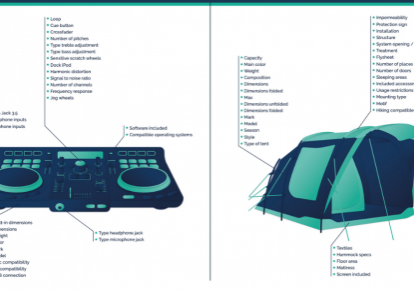
The Shoppingfeed development headquarters has been buzzing with energy this past year. We’ve undertaken a complete overhaul of our product tagging system, using Product Graph technology as the primary driver of how our customers’ product information is assigned, stored and retrieved.
A little background on graph technology
Graph technology builds databases using mathematical graph theory, storing data and links between the data points as relationships. While the underlying math is quite complex, the crux is that graph databases emphasize the semantic connections between data as much as the individual data points by explicitly storing those connections as relationships.
Why should you care about relationships? Because much of the value residing in your data comes from unearthing information on the connections between data points. Google began using graph technology a few years ago, and its popularity has begun spreading to industries like Ecommerce services.
One familiar use case scenario: you want to discover which of your followers on social media bought a certain product in your online store as a result of a certain campaign.
It’s a transformation that goes way beyond tagging, which worked well enough in the past. But to accelerate sales growth, product tagging has to become a lot more AI-driven. You have to teach your system not just to think, but to think using the many different patterns that real human shoppers do.
Though not quite completed, we’re nearing the finish line. So we thought we’d tell you now about the big changes we’ve implemented.
How Product Graph technology can help you scale up
Shopping Feed will now be using our proprietary Product Graph technology in all of the feeds we syndicate, with a slew of new tools for our users to make scaling up your store faster, simpler, yet more powerful than ever before.
Better organic marketplace reach
Expanded OMR will result in getting your products in front of more searchers, no matter how quirky they are in phrasing the query. Our database has grown from 8 million to 12 million attributes, helping you outsmart your competitors on all marketplaces.
New Color/Size dashboard
Our new color/size dashboard offers a unique way to assign color and size attributes. It’s the first of its kind in our industry!
15-minute updates on over a million products
Channel per channel, we are upgrading to provide a full update on inventory, pricing, syndication, and order processing data management every 15 minutes. For Enterprise merchants, it features shorter sync windows and instant updates.
More A.P.I. partners
Every month, Shoppingfeed is adding new channel partners to its API network. This brings you lots more choices when it comes to new shipping platforms and re-pricing software. We are one of the few syndication services offering Zapier integrations, which helps you automate a lot of your routine functions.
Working with other recent updates in our V3 series, we’ve made improvements to our A.P.I. for better home page readouts, product graph tagging, order dashboards and setup paths.
New nested menu organization
For easier navigation, we’ve moved all menus to the left, with nesting features for details.
New marketplaces and integrations
By the end of this year, our clients can expect to see more than 10 new marketplace channels added, as well as 4 new storefront integrations, including WooCommerce, Big Commerce, and Plytix.
We’re very excited about all these changes, and eager to show you how they will help you move more products and scale your business to new heights.
Shoppingfeed syndicates search-optimized product listings on all of the world’s most powerful marketplaces, syncs and refines inventory data, and eases fulfillment with automated workflows.




